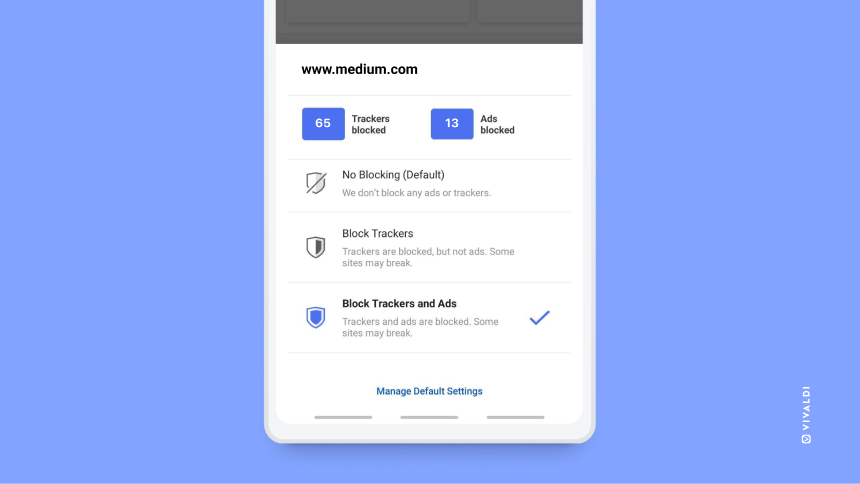Vivaldi Tips
A huge collection of Vivaldi browser tips, tricks and hacks.
Tip #347
September 14, 2023
Share text with a link to the source from Vivaldi on Android.
“Copy link to highlight” (see Tip #169) is a great feature for sharing a specific part of a web page quickly. Instead of sharing a link and instructing the recipient to scroll past 5 paragraphs of text and 3 images, they’ll be taken to the exact spot you want to highlight (as long as they also use a browser that supports this feature). While on desktop only the link is shared, on Android the highlighted text is also included in the message.
To share text from Vivaldi on Android:
- Highlight some text on a web page.
- Select “Share” from the menu that appears.
- Select the app you want to share the text and link with or tap on Copy.
- Follow the app’s sharing steps or paste the text and link to a place of your choice.

Tip #346
September 13, 2023
Search copied text in a new tab with a single shortcut.
Combining actions often used one after another into a single Command Chain can help you streamline your browsing. One of the many Command Chains you can create is searching for text you have copied to the clipboard in a new tab. That way you can skip opening a new tab, focusing on the address field, pasting your search term in it, and executing the search. It’s all done with the use of a single shortcut or click of a button.
To create the Command Chain:
- Go to Settings > Quick Commands > Command Chains.
- Click on
 “Add Command Chain” below the list of existing chains.
“Add Command Chain” below the list of existing chains. - Give the new chain a name
- Add the following commands:
- New Tab,
- Delay (with the parameter value, for example, 100),
- Focus Address Field,
- Paste and Go.
- Go to Settings > Keyboard and/or Settings > Mouse, look for the new chain in the list of commands, and create a shortcut for it.
In addition, you can open the Toolbar Editor and add the new chain as a button on one of the browser toolbars.
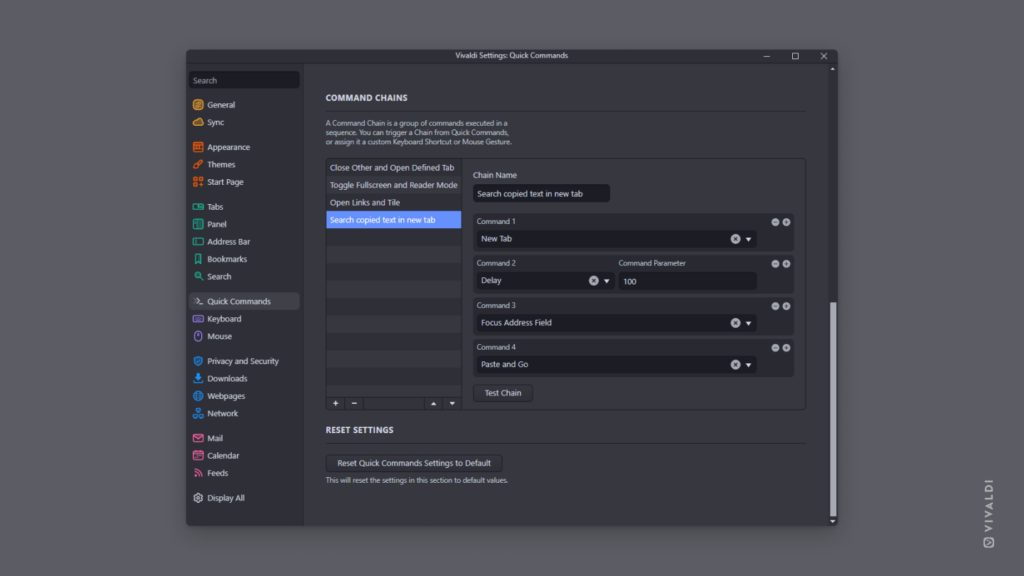
Tip #345
September 12, 2023
Move the Bookmark Bar to the bottom of the window together with the Address and Tab Bar.
Do you prefer to have your important toolbars on the lower side of the browser window? Vivaldi’s flexible customization options allow you to move the toolbars, including the Bookmark Bar, to many different locations.
To move the Bookmark Bar to the bottom:
- Go to Settings > Bookmarks > Bookmark Bar > Bookmark Bar Position.
- Select “Bottom”.
You can also move the Address and Tab Bars to the bottom of the window from Settings > Address Bar and Settings > Tabs, respectively.
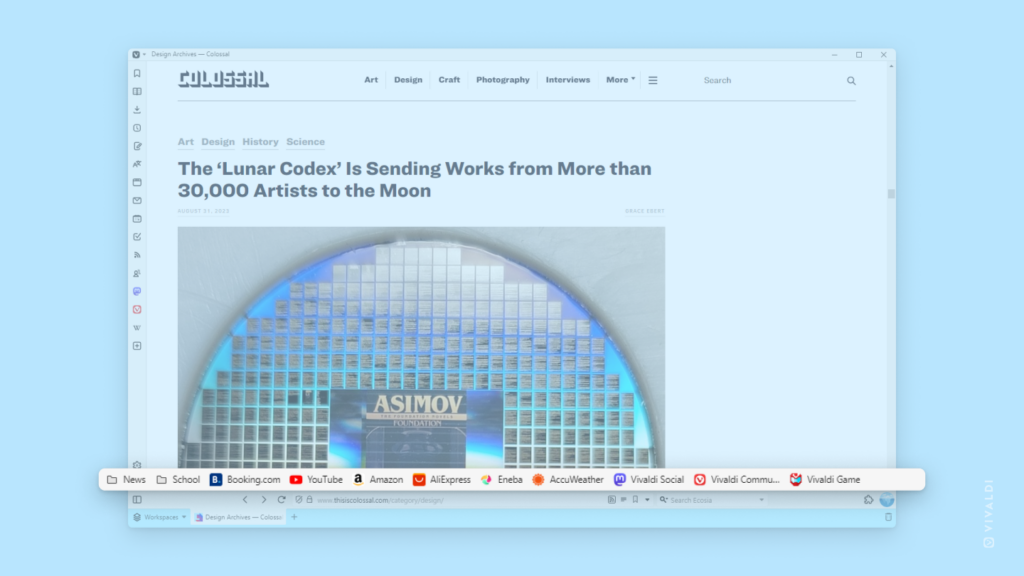
Tip #344
September 11, 2023
Import bookmarks, passwords, and more from your old browser to Vivaldi.
In case you weren’t ready to import your browser data from your previous browser during your first use of Vivaldi, you can do it anytime by following the instructions below.
To import data to Vivaldi:
- Open the
 Vivaldi menu > File > Import from Applications or Files.
Vivaldi menu > File > Import from Applications or Files. - Select the browser (and its profile) you want to import data from.
- Select the data (bookmarks, passwords, history, etc.) you want to import.
- Click “Start Import”.
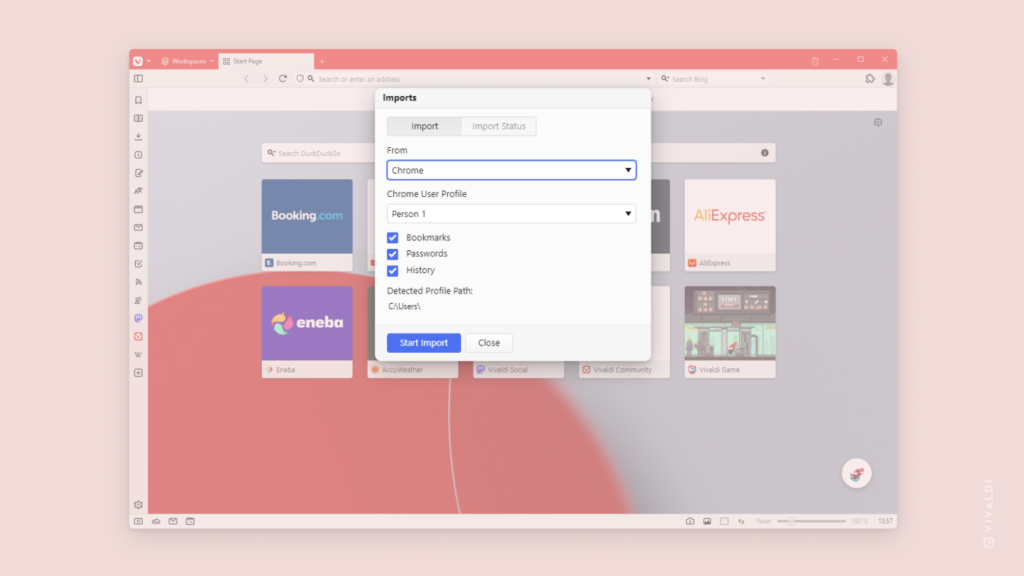
Tip #343
September 8, 2023
Tweak your browser theme by changing the corner rounding.
Do you like your UI elements rounded or do you prefer sharper corners? Vivaldi has you covered, so you can make things just the way you want them.
To change the corner rounding of the browser UI:
- Go to Settings > Themes > Editor > Settings > Corner Rounding.
- Move the slider left and right until you find the perfect roundness.
Tip #342
September 7, 2023
Show off your personality with a cover image on your Forum profile.
When you’ve been on the Forum for a bit and have managed to earn a couple of reputation points, you can start customizing your profile. One way to add some character to your account is by adding a cover image to your profile.
To upload a cover image:
- Go to your Forum’s profile on https://forum.vivaldi.net/me.
- Hover over the cover image and click on the Upload button on the left.
- Click on “Choose File” to select the image file.
- Click Upload.
- If needed, rotate, flip and/or crop the image.
- Click “Crop and upload”.
If you want to adjust the image, hover over the cover again and click on the middle button with arrows to move the image. Click “Save” when you’re satisfied with the result.
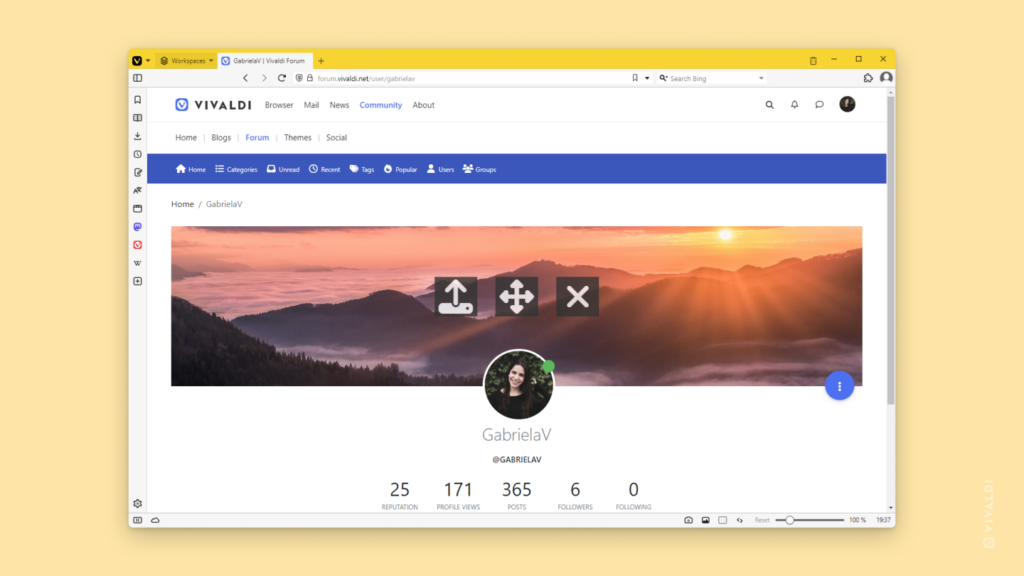
Tip #341
September 6, 2023
Enable Reader View for a distraction-free reading experience on Vivaldi on Android.
Web pages often come with a lot of content on them and focusing on the article you’re there to read can be a bit difficult with all the distractions. Enabling Reader View aka Simplified View on Android removes all but the main article, allowing you to focus on what’s important.
To enable Reader View on Android:
- First, go to Settings > Web Pages > Accessibility.
- Enable “Simplified view for web pages”.
- Then find a web page with an article you’d like to read. When Reader View can be enabled, a prompt will appear on top of the page.
- Tap on “View” to enable Reader View.
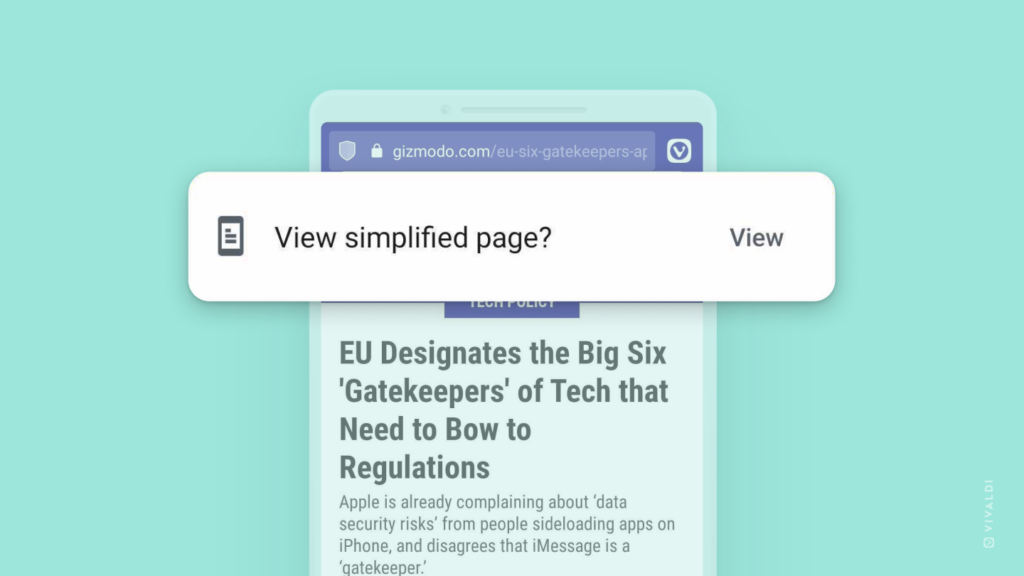
Tip #340
September 5, 2023
Set an Extension as the New Tab Page in your Vivaldi browser.
When you open a new tab in Vivaldi, you have various options for what’s displayed in the new tab before you navigate to a web page. You can choose between the Start Page, Home Page, Blank Page, or a web page of your choice. But there’s one more option – a New Tab Page Extension.
To set an extension for the new tab:
- Install an extension of your choice from Chrome Web Store.
- Go to Settings > Tabs > New Tab Page.
- Make sure Start Page is chosen and then enable “Controlled by Extension”.
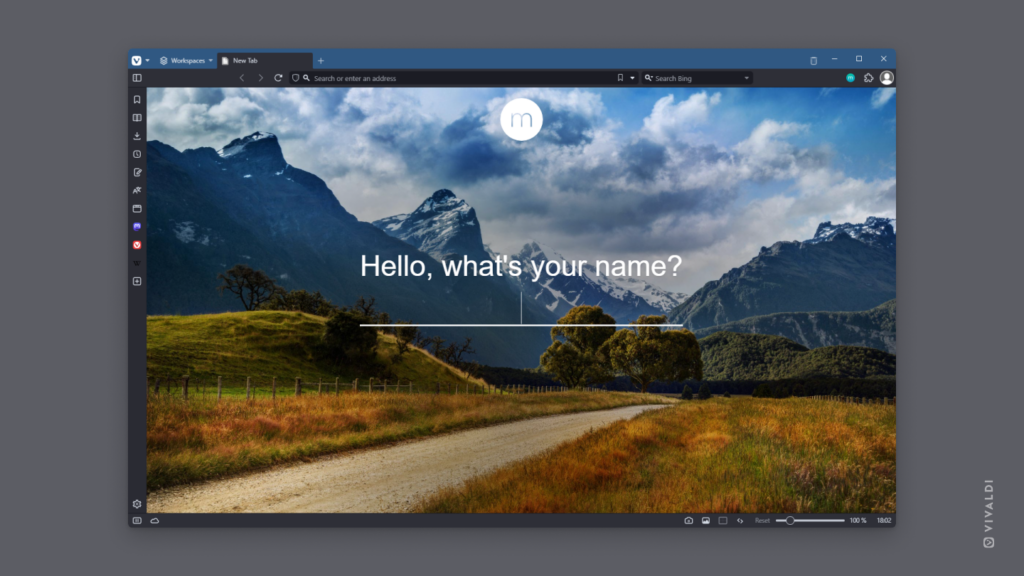
Tip #339
September 4, 2023
Reorder Address Field drop-down menu’s categories according to your preferences.
Do you use the Address Field search more for finding an entry in your History than for Bookmarks? Or do you want Frequently Visited Pages to be listed before Search Suggestions? In the Vivaldi browser, you can tailor the drop-down menu according to your needs.
To reorder the drop-down:
- Go to Settings > Address Bar > Drop-Down Menu Priority.
- Select a category you want to move.
- Using the arrows in the bottom right corner, move the category up or down.
Alternatively, drag and drop the categories to reorder them.
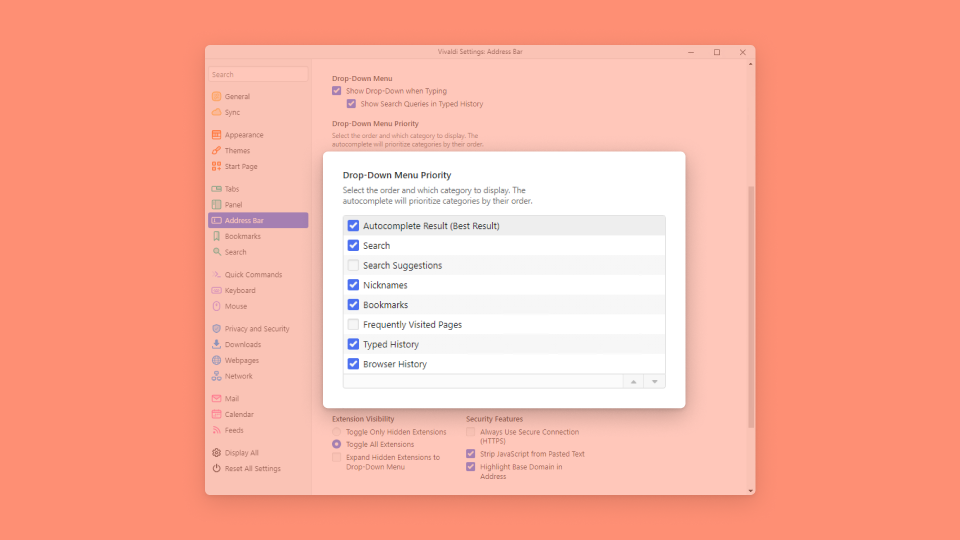
Tip #338
September 1, 2023
Hide boosts on Vivaldi Social to only see original posts from the account you follow.
Is an account you follow on Vivaldi Social boosting a little too many posts by other authors while you’re only interested in the posts they make? If that’s the case, you can easily hide their boosts.
To hide boosts from someone:
- Go to the account’s profile.
- Click on the
 Menu button next to the Unfollow and Notification buttons.
Menu button next to the Unfollow and Notification buttons. - Select “Hide boosts from …”.
Going forward you’ll only see their own posts in your Home feed. By visiting their profile, you can still take a look at what they’ve been boosting.
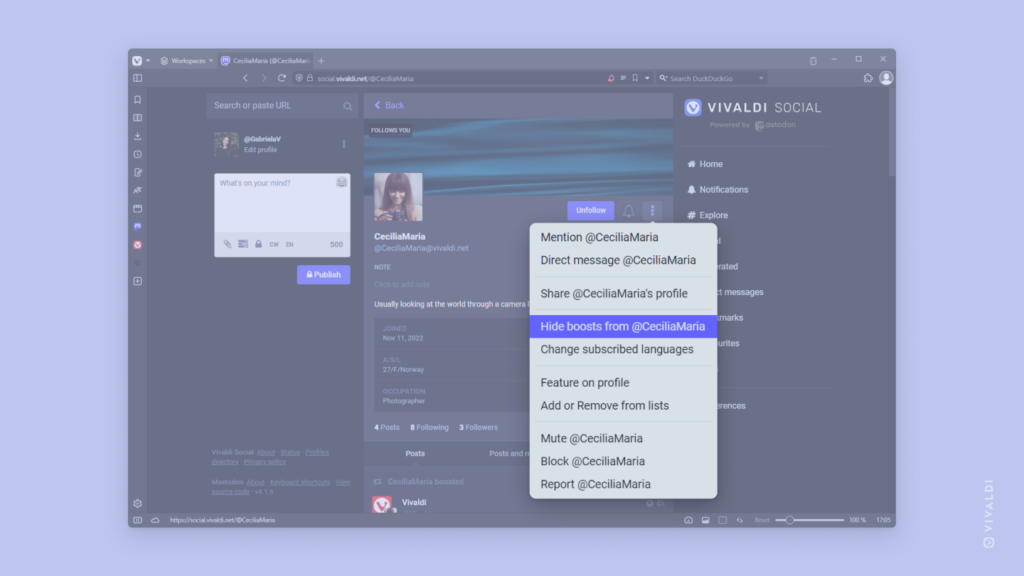
Tip #337
August 31, 2023
Let go of the past by deleting your browser data.
It can be convenient to find a page you recently visited or a file you downloaded, but it’s also good to get rid of unnecessary data every now and then. In Vivaldi you can choose what to delete and for what time period.
First, select one of the following ways to open the data deletion tool:
- Open the
 Vivaldi menu > Tools > Delete Browsing Data.
Vivaldi menu > Tools > Delete Browsing Data. - Click the
 Clear Browsing Data button in the top-right of the History page.
Clear Browsing Data button in the top-right of the History page. - Click the
 Clear Browsing Data button in the top-right corner of the History Panel.
Clear Browsing Data button in the top-right corner of the History Panel. - Type “Delete Browsing Data” in Quick Commands.
- Use the Keyboard Shortcut
Ctrl Shift Del/⇧ ⌘ ⌫; - Create a Mouse Gesture for the action.
Then select the timeframe for which you want to delete the data and the data types. Finish by clicking Delete.
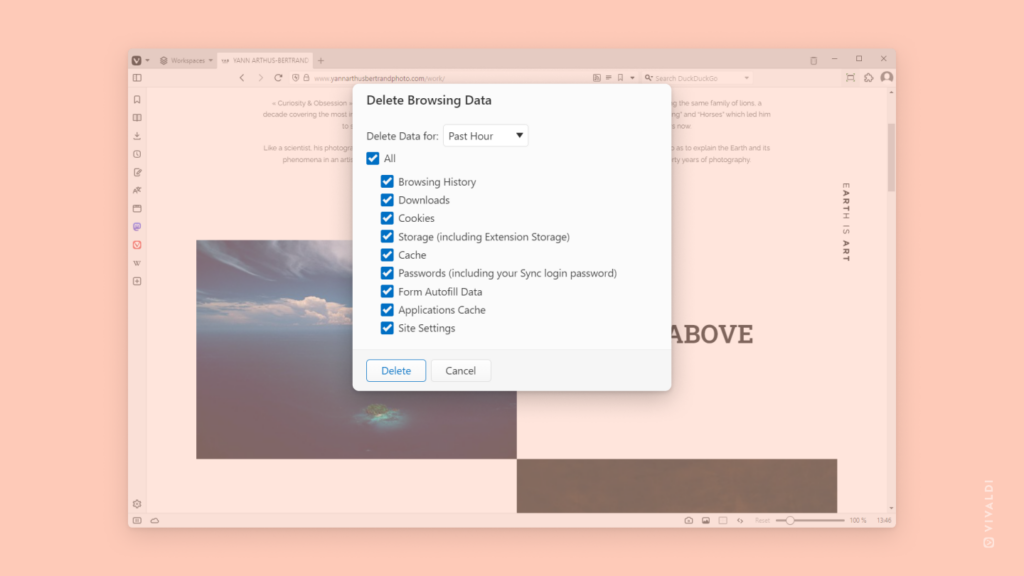
Tip #336
August 30, 2023
Adjust tracker and ad blocking level per site from Vivaldi on Android’s Address Bar.
Let’s say you block all ads and trackers by default but want to make an exception for a specific website that you trust or, maybe, the site behaves strangely, so you want to check whether disabling the content blocker will solve the issue. In that case, while the website you want to change the blocking level for is open in the active tab:
- Tap on the
 Content Blocker button on the left side of the Address Bar.
Content Blocker button on the left side of the Address Bar. - Choose between:
- No Blocking,
- Block Trackers, or
- Block Trackers and Ads.
You can view and manage all websites you’ve set a separate blocking level for in Settings > Privacy > Tracker and Ad Blocking > Exceptions.
